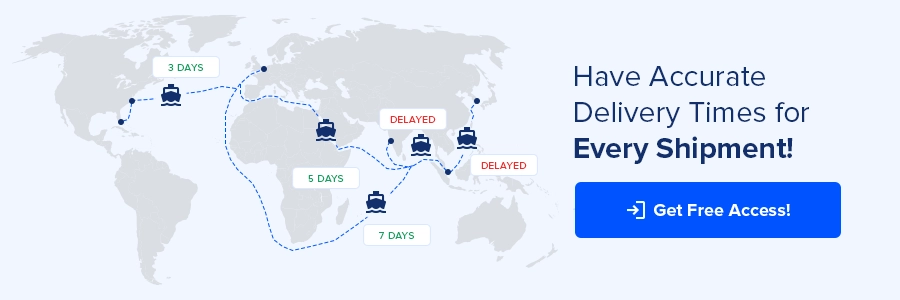Predictive Geofencing: The Future of Global Logistics Operations
Global logistics thrives on precision, real-time updates, and seamless coordination. Geofencing has emerged as a key enabler, allowing supply chain managers to track containers effectively by setting virtual boundaries around specific locations.
However, the evolution of this technology into predictive geofencing is a game-changer, enabling companies to foresee disruptions and proactively optimize container routes. This blog explores how geofencing empowers supply chain teams to ensure smooth operations and minimize risks in global supply chains.
What is Predictive Geofencing and How Does it Work?
Predictive geofencing takes traditional logistics a step further by combining real-time tracking with data-driven forecasting. It leverages geofence-enabled triggers and historical trends to anticipate disruptions and optimize container routes before problems arise.
Here’s how it works:
Location-Based Triggers: Virtual boundaries are set around ports, warehouses, or key transit points. When a container enters or exits these zones, alerts are automatically triggered, enhancing logistical efficiency.
Automated Alerts: Predictive geofencing monitors conditions like port congestion, weather changes, or customs delays, alerting teams before they impact operations, proving its value in geofencing supply chain strategies.
Data Integration: By analyzing historical and real-time data, it enables more accurate forecasts of potential risks, making rerouting or scheduling adjustments more efficient for logistical applications.

Understand Predictive Geofencing:
Watch it Work With Our Interactive Demo.
Benefits of Geofencing Logistics in Supply Chains
Proactively Managing Disruptions in Global Routes
Identifying Bottlenecks: Predictive geofencing helps logistics managers foresee potential delays caused by weather, congestion, or geopolitical issues, ensuring better supply chain resilience.
Reducing Rerouting Time: Automated alerts triggered by geofence breaches enable quick decisions, reducing downtime and ensuring shipments stay on schedule.
We can see such benefits in its implementation during the Red Sea Crisis.
Enhancing Container Visibility and Security
Tracking High-Value Shipments: Geofencing provides constant oversight, ensuring that valuable cargo is safe throughout transit.
Preventing Unauthorized Movement: Alerts triggered by geofence violations prevent theft or unauthorized detours, securing supply chain integrity.
Optimizing Container Routes with Data-Driven Insights
Efficient Route Selection: Geofence-based data identifies optimal transport routes, minimizing delays and maximizing efficiency in logistics.
Reducing Environmental Impact: By predicting and avoiding inefficient routes, companies lower fuel consumption and achieve more on-time deliveries.

Success Stories: Using Predictive Geofencing for Seamless Container Management
Case Study: Reducing Delays with Predictive Geofencing
An international logistics company leveraged predictive geofencing to reduce delays by 30%. By utilizing automated alerts and proactive route optimization, they significantly improved delivery accuracy and reduced rerouting time.
Key Metrics:
- Delays reduced by 30%
- Enhanced delivery accuracy by leveraging alerts data
GoComet’s Geofencing Impact
At GoComet, predictive geofencing plays a vital role in providing real-time visibility:
- About 70% of total ocean trackings on our platform have active geofences on vessel arrivals and departures.
- 83% of shipments arriving at their destination port in the last 24 hours were reported as “Arrived” on our platform before the carrier.
- Clients observed a median update lead time of 8.9 hours ahead of carrier updates, giving them a competitive edge in logistical applications.
How Geofencing Logistics Align with Supply Chain Goals
Boosting Operational Efficiency and Reducing Costs
Streamlining Operations: Predictive geofencing automates responses to disruptions, reducing dependency on manual tracking and strengthening logistical frameworks.
Lowering Costs: Efficient routing, combined with fewer disruptions, translates to significant cost savings for supply chain teams.
Improving Partner Accountability and Customer Satisfaction
Ensuring Partner Performance: Real-time tracking and geofence-triggered updates hold logistics partners accountable for delivery performance, enhancing outcomes.
Enhancing Customer Experience: Sharing geofence-enabled updates proactively keeps customers informed, improving trust and satisfaction in supply chain operations.

Conclusion
Geofencing is transforming global logistics by anticipating disruptions and optimizing container routes. Its ability to combine real-time tracking with data-driven insights empowers businesses to operate more efficiently while minimizing risks.
With proven results like reduced delays, improved delivery accuracy, and enhanced customer satisfaction, predictive geofencing is an invaluable tool for modern supply chains. Embrace these solutions today to ensure seamless operations and stay ahead in a competitive landscape.

